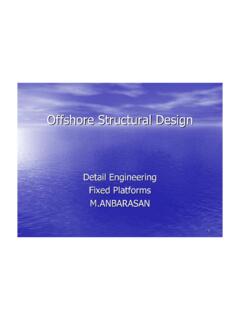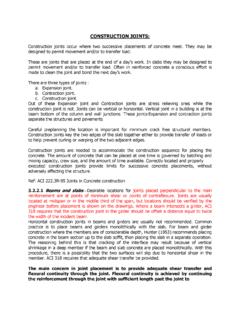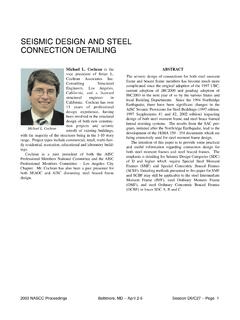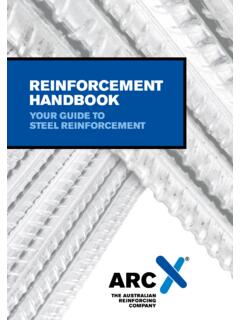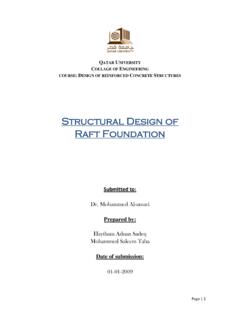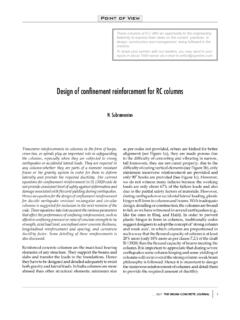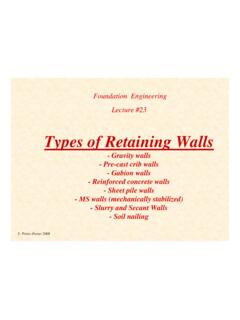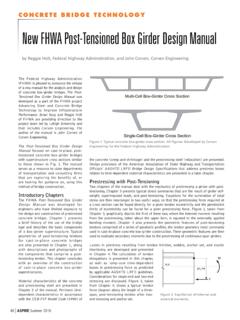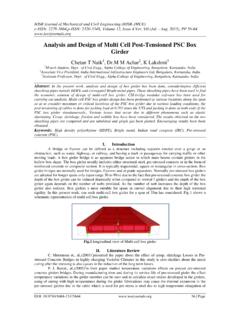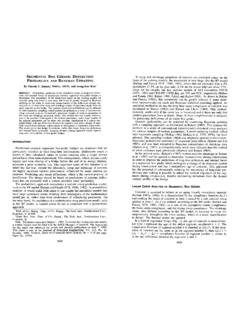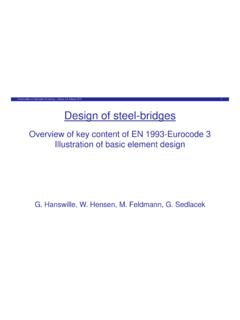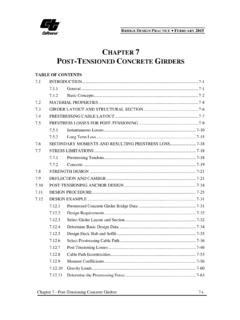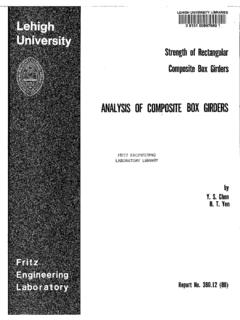Transcription of :DIFFERENT TYPES OF BRIDGES AND ITS SUITABILITY: A …
1 : different TYPES OF BRIDGES AND ITS suitability : A PAPER BY Prof. P. C. Vasani, Applied Mechanics Department, L. D. College of Engineering, Ahmedabad 380015. Ph. No. (079)7486320 Mobile No:9825342208 Bhumika B. Mehta M. E. CIVIL - (CASAD) Sem - III B-2, Kalindi Flats, Opp. Kadwa Patidar Boarding, C. G. Road, Ahmedabad 380006. Ph. No. (079)6561093 PDF created with FinePrint pdfFactory trial version : different TYPES OF BRIDGES AND ITS suitability : v Definition A bridge is a structure providing passage over an obstacle without closing the way beneath. The required passage may be for a road, a railway, pedestrians, a canal or a pipeline. The obstacle to be crossed may be a river, a road, railway or a valley. In other words, bridge is a structure for carrying the road traffic or other moving loads over a depression or obstruction such as channel, road or railway.
2 A bridge is an arrangement made to cross an obstacle in the form of a low ground or a stream or a river without closing the way beneath. v Components of bridge The bridge structure comprises of the following parts. Superstructure or Decking This includes slab, girder, truss, etc. This bears the load passing over it and transmits the forces caused by the same to the substructures. Bearings The bearings transmit the load received from the decking on to the substructure and are provided for distribution of the load evenly over the substructure material which may not have sufficient bearing strength to bear the superstructure load directly. Substructure This comprises piers and abutments, wing walls or returns and their foundation. Piers and Abutments These are vertical structures supporting deck/bearing provided for transmitting the load down to the bed/earth through foundation.
3 Wing walls and Returns These are provided as extension of the abutments to retain the earth of approach bank which otherwise has a natural angle of repose. Foundation This is provided to transmit the load from the piers or abutments and wings or returns to and evenly distribute the load on to the strata. This is to be provided sufficiently deep so that it is not affected by the scour caused by the flow in the river and does not get undermined. While the above mentioned are structurally operational parts, for safety hand rails or parapets, guard rails or curbs are provided over the decking in order PDF created with FinePrint pdfFactory trial version prevent vehicle or user from falling into the stream or for the separation of traffic streams. v Classification BRIDGES may be classified in many ways, as below. According to the flexibility of superstructure as fixed span BRIDGES or movable BRIDGES .
4 Fixed span superstructure In case of fixed span superstructure, the superstructure remains in a fixed position and most of the BRIDGES are of this category. Movable span BRIDGES In case of movable span superstructure, the superstructure is lifted or moved with the help of some suitable arrangement. According to the position of bridge floor relative to the formation level and the highest flood discharge as deck BRIDGES , through BRIDGES or semi-through BRIDGES . Deck BRIDGES Deck-type BRIDGES refer to those in which the road deck is carried on the top flange or on top of the supporting girders . The deck slab or sleeper may cantilever out to some extent beyond the extreme longitudinal girder. Deck BridgeHFLFORMATION LEVEL Through BRIDGES In the through type BRIDGES , the decking is supported by the bottom flange of the main supporting girders provided on either side. FORMATION LEVELT hrough BridgeHFL PDF created with FinePrint pdfFactory trial version Semi through BRIDGES The semi-through bridge has its deck midway and the deck load is transmitted to the girder through the web of the girder.
5 In this also, the main girders are on either side of deck. FORMATION LEVELSemi-through BridgeHFL According to the inter-span relations as simple, continuous or cantilever BRIDGES . Simply supported Generally width of bridge is divided into number of individual spans. For each span, the load carrying member is simply supported at both ends. The plate girder and truss girders are used as this type of BRIDGES . They are suitable at places where uneven settlements of foundations are likely to take place. Continuous In continuous BRIDGES spans are continuous over two or more supports. They are statically indeterminate structures. They are useful when uneven settlement of supports does not take place. In continuous BRIDGES the bending moment anywhere in the span is considerably less than that in case of simply supported span. Such reduction of bending moment ultimately results in the economic section for the bridge .
6 In continuous BRIDGES the stresses are reduced due to negative moments developed at pier or supports. Thus continuous span BRIDGES have considerable saving compared to simply supported bridge construction. Following are the advantages of RCC continuous girder BRIDGES over simply supported girder BRIDGES . o As the bearings are placed on the centerline of piers, the reactions at piers are transmitted centrally. o It is found that the continuous girder bridge suffers less vibration and deflection. o The continuous girder bridge requires only one bearing at each pier as against two bearing for simply supported girder bridge . PDF created with FinePrint pdfFactory trial version The depth of decking at mid span is reduced and it may prove to be useful for over BRIDGES where headroom is of prime consideration. o The expansion joints required will be less. o There is reduction in cost as less quantity of concrete and steel are required.
7 Following are the disadvantages of RCC continuous girder BRIDGES over simply supported girder BRIDGES . o The design is more complicated as it is a statically indeterminate structure. o The detailing and placing of reinforcements are to be carried out with extreme care. o The placing of concrete and removal of formwork are to be executed carefully in proper sequence. Cantilever A cantilever bridge is formed of cantilevers projecting from supporting piers. The ends of a cantilever bridge are treated as fixed. A cantilever bridge combines the advantages of a simply supported span and a continuous span. For long spans and deep valleys and at places where it will not be practicable to use centering, cantilever BRIDGES are more suitable. They are suitable in case of uneven settlement of foundation. The construction of a cantilever bridge may either be of simple type or of balanced type.
8 Cantilever SpanCantilever SpanCantilever bridge with simple construction In case of cantilever bridge with balanced type of construction, hinges are provided at the points of contraflexure of a continuous span and an intermediate simply supported span is suspended between two hinges. PDF created with FinePrint pdfFactory trial version bridge with simple constructionCantilever SpanCantilever SpanSimply Supported According to the form or type of superstructure as arch, beam, truss, slab, rigid frame or suspension BRIDGES . Slab Beam Beam bridge Girder Girder bridge Truss The girder/beam as well as the truss can be made up of timber, steel or concrete, or can be made up of combination of steel and concrete. Truss Girder bridge PDF created with FinePrint pdfFactory trial version Arch Barrel Type Arch bridge Suspension Suspension bridge Suspension BRIDGES are made up of high tensile steel cables strung in form of catenaries to which the deck is attached by steel suspenders, which are mainly made up of steel rods/members/cables.
9 The decking can be of timber, concrete or steel spanning across the stiffening girders transmitting load to the suspenders. Cable stayed Cable-stayed BRIDGES are similar to the suspension BRIDGES excepting that there will be no suspenders in the cable-stayed BRIDGES and a number of these can be of masonry, concrete or steel. Various economical span ranges for these TYPES generally adopted are: Arch : For small spans of 3 to 15m in masonry, steel arch up to 519m and concrete arches up to 305m spans. Slabs : Up to 9m. girders and beams : 10 to 60m (exception up to 250m in continuous construction). Trusses : 30 to 375m simply supported and up to 550m with cantilevered combination. Suspension BRIDGES : Over 500m up to 1400m. PDF created with FinePrint pdfFactory trial version Stayed : 300 to 600m. According to the materials of construction used for superstructure as cement concrete, prestressed concrete, steel, masonry, iron, timber or composite BRIDGES .
10 The earliest form of materials used for construction of BRIDGES was first stone and later brick. The masonry BRIDGES are used for short spans and according to availability of material and skilled labour. They are mainly of arch type of BRIDGES . The next form of construction was Timber bridge in which timber was used for spanning the gap and also for supporting the beams. Timber BRIDGES are used for short spans, light loads and for use as temporary and unimportant BRIDGES . With the invention and development of concrete, BRIDGES are being built entirely with concrete, either reinforced or prestressed or a combination of both for superstructure. Many combination of above TYPES are also possible. The common examples of composite construction are: o Concrete beams reinforced with steel bars. o Precast prestressed concrete girder with cast-in-situ RCC slab. o Rolled steel joists topped by a cast-in-situ RCC slab.
